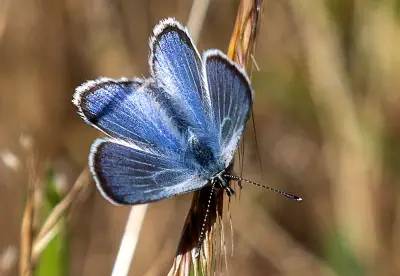Is there life after extinction? Some scientists and conservationists are trying to find out

On a shrub-covered dune in San Francisco s Presidio biologist Durrell Kapan and a group of assistants huddle around a tiny plastic condiment container placed delicately amid a cluster of orange-yellow flowers Inside is a Silvery Blue butterfly whose inch-long wings beat sleepily revealing its shimmering namesake hue as it sips on a cotton ball doused in fruit punch Gatorade Related Articles Trump signs executive orders to boost nuclear power speed up approvals Louisiana stifles population air monitoring with threat of million-dollar fines federal lawsuit says Tax bill passed by House Republicans would gut Biden-era clean strength tax credits Senate votes to block California s rule banning the sale of new gas-powered cars by On World Bee Day the bees did not seem bothered They should be Just over years ago Xerces Blue Butterfly last flapped its wings over the Presidio becoming the first butterfly on the continent known to go extinct as a conclusion of human activity Now by releasing this Silvery Blue and over a hundred others over the past year Kapan hopes there can be selected sort of life after extinction with these butterflies filling the role in the ecosystem that the Xerces once did De-extinction the idea of bringing species back from beyond the brink or filling their role with surrogate creatures has been an effort for decades But last month that idea burst into the popular consciousness when the stark white coats of Dire wolves which several scientists say might be better described as genetically modified grey wolves graced the covers of magazines across the world Led by a researcher from UC Santa Cruz a group of scientists claimed to bring back the creature after it had been extinct for over years The idea of de-extinction is that it s part of the spectrum of restoring lost species and ecological roles in environments revealed Ben Novak lead scientist at the Sausalito-based conservation philanthropy Revive Restore Both the wolf and the butterfly are part of a larger push by scientists and philanthropists across the Bay Area to bring back species from extinction or replace their roles in the name of conservation While various in the movement say their work could be essential for preserving life on earth several fear that use or abuse of these techniques could be a distraction or worse harm the very conservation cause they claim to fight for We need new tools to address conservation problems that s essential noted Ryan Phelan co-founder of Revive Restore who helped create a nexus of researchers ethicists and conservationists interested in biotech and de-extinction These new tools need to be developed responsibly and with open transparency No new instrument the present day can replace the need to protect habitat Biologists and conservationists largely agree that we are in the midst of a biodiversity emergency a rapid loss in populations and widespread extinctions of animals plants and other organisms across the globe fueled by human activity like habitat destruction a changing weather and corruption While estimates vary a few studies suggest the planet is losing species at least times faster than the natural rate we might expect As a species disappears from the circumstances so too does its role in its habitat For example a group of grey wolves might keep the elk population in check Without the wolves elk might overgraze chomping down on flora that would otherwise grow into food or roosts for other species It s like a Jenga stack When a species goes extinct you create a gap in that fragile structure Life and ecosystems are a little bit like that announced Douglas McCauley a professor at UC Santa Barbara and UC Berkeley who co-wrote ethical guidelines to de-extinction So what you want to do is you want to fill those blocks back in For a multitude of in the Bay Area rebuilding that Jenga stack is the goal of de-extinction to release a group of animals that can fill in a key role in the conditions and stabilize an ecosystem In Revive Restore partnered with Kapan at the California Academy of Sciences to look into the genetics of the Xerces butterfly with an eye towards restoring it to the Presidio Kapan and his collaborators investigated the DNA of the extinct Xerces and analyzed historical records of the butterfly s behavior and habitat Then they compared the genes and the atmosphere to other species of butterfly and detected the Silvery Blue a butterfly out of California s Central Coast with a similar penchant for foggy dunes and certain shrubs as the Xerces Scientists and contributors from the California Academy of Sciences release Silvery Blue butterflies in the sand dunes of the Presidio in San Francisco Calif Tuesday April in the hopes of filling the role of the Xerces butterfly that went extinct years ago Karl Mondon Bay Area News Group Silvery Blue butterflies wait in condiment containers for their release by scientists from the California Academy of Sciences into the sand dunes of the Presidio in San Francisco Calif Tuesday April The release is part of an effort to fill the role played by the Xerces butterfly that went extinct years ago Karl Mondon Bay Area News Group Scientists and participants from the California Academy of Sciences release Silvery Blue butterflies in the sand dunes of the Presidio in San Francisco Calif Tuesday April in the hopes of filling the role of the Xerces butterfly that went extinct years ago Karl Mondon Bay Area News Group A Silvery Blue butterfly issued by scientists from the California Academy of Sciences clings to a safety net momentarily as it enters the sand dunes of the Presidio in San Francisco Calif Tuesday April The Silvery Blue release is part of an effort to fill the role played by the Xerces butterfly that went extinct years ago Karl Mondon Bay Area News Group A volunteer from the California Academy of Sciences tries to photograph the release of Silvery Blue butterfly in the sand dunes of the Presidio in San Francisco Calif Tuesday April The Silvery Blue release is part of an effort to fill the role played by the Xerces butterfly that went extinct years ago Karl Mondon Bay Area News Group Durrell Kapan a scientists with the California Academy of Sciences oversees the release of Silvery Blue butterflies in the sand dunes of the Presidio in San Francisco Calif Tuesday April Kapan is hoping the colorful insect can fill the role of the Xerces butterfly that went extinct years ago Karl Mondon Bay Area News Group Durrell Kapan a scientists with the California Academy of Sciences oversees the release of Silvery Blue butterflies in the sand dunes of the Presidio in San Francisco Calif Tuesday April Kapan is hoping the colorful insect can fill the role of the Xerces butterfly that went extinct years ago Karl Mondon Bay Area News Group Scientists and participants from the California Academy of Sciences release Silvery Blue butterflies in the sand dunes of the Presidio in San Francisco Calif Tuesday April in the hopes of filling the role of the Xerces butterfly that went extinct years ago Karl Mondon Bay Area News Group A Silvery Blue butterfly issued by scientists from the California Academy of Sciences rests in the sand dunes of the Presidio in San Francisco Calif Tuesday April The Silvery Blue release is part of an effort to fill the role played by the Xerces butterfly that went extinct years ago Karl Mondon Bay Area News Group Show Caption of Scientists and assistants from the California Academy of Sciences release Silvery Blue butterflies in the sand dunes of the Presidio in San Francisco Calif Tuesday April in the hopes of filling the role of the Xerces butterfly that went extinct years ago Karl Mondon Bay Area News Group Expand The butterfly might be able to serve as pollinator and prey like the Xerces filling its empty role in the ecosystem So over the last year Kapan and his association captured over Silvery Blues from Monterey County and brought them to the Presidio to release them Kapan calls the experiment a test event of what people are calling de-extinction allowing him and others to gain insight into what happens when you try to replace an extinct species with a new one De-extinction though has another side fueled by st-century advances in genetics that rival science fiction Habitats around the world are changing at a rate that is faster than evolution can keep up commented UCSC biologist Beth Shapiro If we want a future that is both biodiverse and filled with people we need to be increasing the tools at our disposal that allow us to help species we need to directly modify genes Shapiro wrote the book on de-extinction How to Clone a Mammoth after becoming a world leader in extracting and deciphering DNA from ancient remains She detailed the initiatives to creating a creature for de-extinction In brief summation she wrote figure out the genes of an extinct creature tweak the genes of a close relative so that it might have key traits of the extinct one find a good surrogate mom figure out how to raise it and release it ideally along with countless of its kin into the wild Then last year Colossal Biosciences a biotech startup dedicated to de-extinction tapped Shapiro to serve as their chief science officer That s where she helped bring back the Dire wolf or something like it According to Colossal the company s scientists extracted ancient DNA from millennia-old Dire wolf bones Using that prehistoric code as a guide they edited a handful of genes in grey wolf cells for traits they linked to Dire wolves like a bigger frame and longer hair They then moved their genes into embryos that when carried by surrogate dog moms produced wolves with fluffy white coats and selected dire wolf traits While selected including Phelan argued that this could be a considerable stride in the science of de-extinction any possible advances were lost in a flurry of media coverage and debate over scientific rigor and thorny ethical quandaries Multiple proponents of de-extinction as a possible tool worried that Dire wolves no longer have a role in the circumstances there are no more wooly mammoths or giant sloths for the beast to hunt It starts to devalue if people think de-extinction is all about Jurassic Park It s just not It s something much more serious it really is about ecosystem restoration reported Phelan Chosen feared that claiming to bring back a species would weaken efforts to protect them fears that were fueled by statements from the Secretary of the Interior and by a push by the Trump administration to weaken the Endangered Species Act We have a higher calling for these tools explained McCauley who called the Dire wolf experiment and its fallout the worst situation scenario for de-extinction It was not just a distraction It truly was a very vital threat to endangered species conservation Others argued that the high-tech exploits would distract money and attention from already-underfunded conservation efforts T he priority ought to be saving endangered species and not attempting to recreate extinct ecological niches declared Ben Sacks director of the Mammalian Ecology and Conservation Unit at UC Davis in an email I think the possible harms of charging forth into the great unknown with shiny tools and hubris to guide conservation efforts are likely to far outweigh any benefits that might come of them Shapiro maintains that the experiment could offer key insight crucial to advancing the science of de-extinction including whether the genetic changes affect the long-term wellness of an animal or its ability to reproduce As of yet there isn t another ideal candidate for de-extinction she argues If we say we re going to go to the moon and the first thing we do is get into orbit are people just mad because we didn t right away go to the moon appealed Shapiro In an attempt to cut through the noise Phelan collaborated with a group of scientists conservationists and ethicists to create a announcement maintaining that while biotechnology could have a key role in conservation it is far from a cure-all and that without laws protecting species and efforts to protect habitats the point of de-extinction is moot While the debate simmers on the gang at Colossal continues to monitor the wolves in their remote preserve in an undisclosed location searching for hints as to how their altered genes might affect them Kapan meanwhile holds that the experiment may give clues to how de-extinction projects might proceed after releasing animals into the wild On one of his trips to monitor the butterflies Kapan and a group of helpers take a walk around the Presidio looking for unmarked Silvery Blue butterflies a sign that particular of those issued last year managed to reproduce A volunteer calls Kapan with a sighting and he rushes to the scene Between them they catch sight of two butterflies that day a female and a male living proof that the species is surviving on its own in the new habitat beating their wings in the wake of extinction


